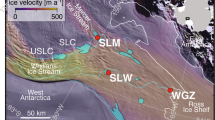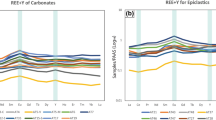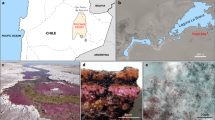Abstract
CRATER Lake is located in a caldera on Mt Mazama, a volcanic centre in the Oregon Cascades which has been active for more than 400,000 years1. The 594-m-deep lake is a consequence of a climactic eruption which occurred 6,845 ±50 years ago; however, caldera volcanism took place as recently as 4,000 years ago1. It has been suggested that some of the physical and chemical features of the lake result from hydrothermal inputs2–7. Here we present submersible observations of the bottom of Crater Lake, which reveal communities of bacteria that are usually associated with anomalously warm, saline waters. The bacteria seem to derive energy from the oxidation of ferrous iron to fuel their metabolism. We propose that the mats are indicators of diffuse hydrothermal venting into the deep lake.
This is a preview of subscription content, access via your institution
Access options
Subscribe to this journal
Receive 51 print issues and online access
$199.00 per year
only $3.90 per issue
Buy this article
- Purchase on Springer Link
- Instant access to full article PDF
Prices may be subject to local taxes which are calculated during checkout
Similar content being viewed by others
References
Bacon, C. & Lanphere, M. A. in Crater Lake: An Ecosystem Study (eds Drake, E. T., Larson, G. L., Dymond, J. & Collier, R.) (Am. Ass. Adv. Sci., San Francisco, in the press).
Van Denburgh, A. S. Geol. Surv. prof. Pap. U.S. No. 1005, 58–60 (1968).
Simpson, H. J. thesis, Columbia Univ. (1970).
Williams, D. L. & Von Herzen, R. P. J. geophys. Res. 88, 1094–1104 (1983).
Thompson, J. M., Nathenson, M. & White, L. D. in Crater Lake: An Ecosystem Study (eds Drake, E. T., Larson, G. L., Dymond, J. & Collier, R.) (Am. Ass. Adv. Sci., San Francisco, in the press).
Nathenson, M. in Crater Lake: An Ecosystem Study (eds Drake, E. T., Larson, G. L., Dymond, J. & Collier, R.) (Am. Ass. Adv. Sci., San Francisco, in the press).
Collier, R. W., Dymond, J., McManus, J. & Lupton, J. in Crater Lake: An Ecosystem Study (eds Drake, E. T., Larson, G. L., Dymond, J. & Collier, R.) (Am. Ass. Adv. Sci., San Francisco, in the press).
Collier, R. et al. Eos 68, 1721 (1987).
Lupton, J. E., Collier, R. & Dymond, J. Eos 68, 1722 (1987).
Collier, R. W. & Dymond, J. Studies of Hydrothermal Processes in Crater Lake Rep. No. 79 CPSU (Oregon State Univ., Corvallis, 1989).
Ehrlich, H. L. Geomicrobiology 393 (Dekker, New York, 1981).
Hanert, H. H. in The Prokaryotes: A Handbook on Habitats, Isolation, and Identification of Bacteria (eds Starr, M. P., Stolp, H., Truper, H. G., Balows, A. & Schlegel, H. G.) 509–515 (Springer, Berlin, 1981).
Wolfe, R. S. in Principles and Applications in Aquatic Microbiology (eds Heukelakian, H. & Dondero, N. C.) 82–97 (Wiley, New York, 1964).
Hanert, H. H. Geol. Rdsch. 62, 786–812 (1973).
Mulder, E. G. & Deinema, M. H. in The Prokaryotes: A Handbook on Habitats. Isolation, and Identification of Bacteria (eds Starr, M. P., Stolp, H., Truper, H. G., Balows, A. & Schlegel, H. G.) 425–440 (Springer, Berlin, 1981).
Karl, D. M., Brittain, A. & Tilbrook, B. Global Venting, Midwater and Benthic Ecological Processes (eds DeLuca, M. P. & Babb, I.) (U.S. Dept of Commerce. Washington, DC. 1988).
Karl, D. M., McMurtry, G. M., Malahoff, A. & Garcia, M. O. Nature 335, 532–535 (1988).
Goldman, J. C., Caron, D. A. & Dennett, M. R. Limnol. Oceanogr. 32, 1239–1252 (1987).
Garrels, R. M. & MacKenzie, F. T. in Equilibrium Concepts in Natural Water Systems (151st Meet. Am. chem. Soc.) 222–242 (Am. chem. Soc., Washington, DC, 1967).
Mariner, R. H., Presser, T. S. & Evans, W. C. Geol. Surv. Open-File Rep. 82–98 (1982).
Fournier, R. O. in Geothermal Systems: Principles and Case Histories (eds Ryback, L. & Muffler, L. P. J.) (Wiley, New York, 1981).
Fournier, R. O. & Potter, R. W. Geochim. cosmochim. Acta 43, 1543–1550 (1979).
Williams, D. L. et al. J. geophys. Res. 84, 7467–7484 (1979).
Maris, C. R. P., Bender, M. L., Froelich, P. N., Barnes, P. N. & Luedtke, N. A. Geochim. cosmochim. Acta 48, 2331–2346 (1984).
Wheat, C. G. & McDuff, R. E. Eos 69, 1499 (1988).
Corliss, J. B., Lyle, M., Dymond, J. & Crane, K. Earth planet. Sci. Lett. 40, 12–24 (1978).
Bostrom, K. & Widenfalk, L. Chem. Geol. 42, 203–218 (1984).
Author information
Authors and Affiliations
Rights and permissions
About this article
Cite this article
Dymond, J., Collier, R. & Watwood, M. Bacterial mats from Crater Lake, Oregon and their relationship to possible deep-lake hydrothermal venting. Nature 342, 673–675 (1989). https://doi.org/10.1038/342673a0
Received:
Accepted:
Issue Date:
DOI: https://doi.org/10.1038/342673a0
This article is cited by
-
Tracing the Seepage of Subsurface Sinkhole Vent Waters into Lake Huron Using Radium and Stable Isotopes of Oxygen and Hydrogen
Aquatic Geochemistry (2016)
-
Iron and Trace Metals in Microbial Mats and Underlying Sediments: Results From Guerrero Negro Saltern, Baja California Sur, Mexico
Aquatic Geochemistry (2011)
-
Subaqueous geology and a filling model for Crater Lake, Oregon
Hydrobiologia (2007)
-
Exploration of a Submerged Sinkhole Ecosystem in Lake Huron
Ecosystems (2006)
-
Biogeochemistry of an Iron-Rich Hypersaline Microbial Mat (Camargue, France)
Microbial Ecology (2005)
Comments
By submitting a comment you agree to abide by our Terms and Community Guidelines. If you find something abusive or that does not comply with our terms or guidelines please flag it as inappropriate.



